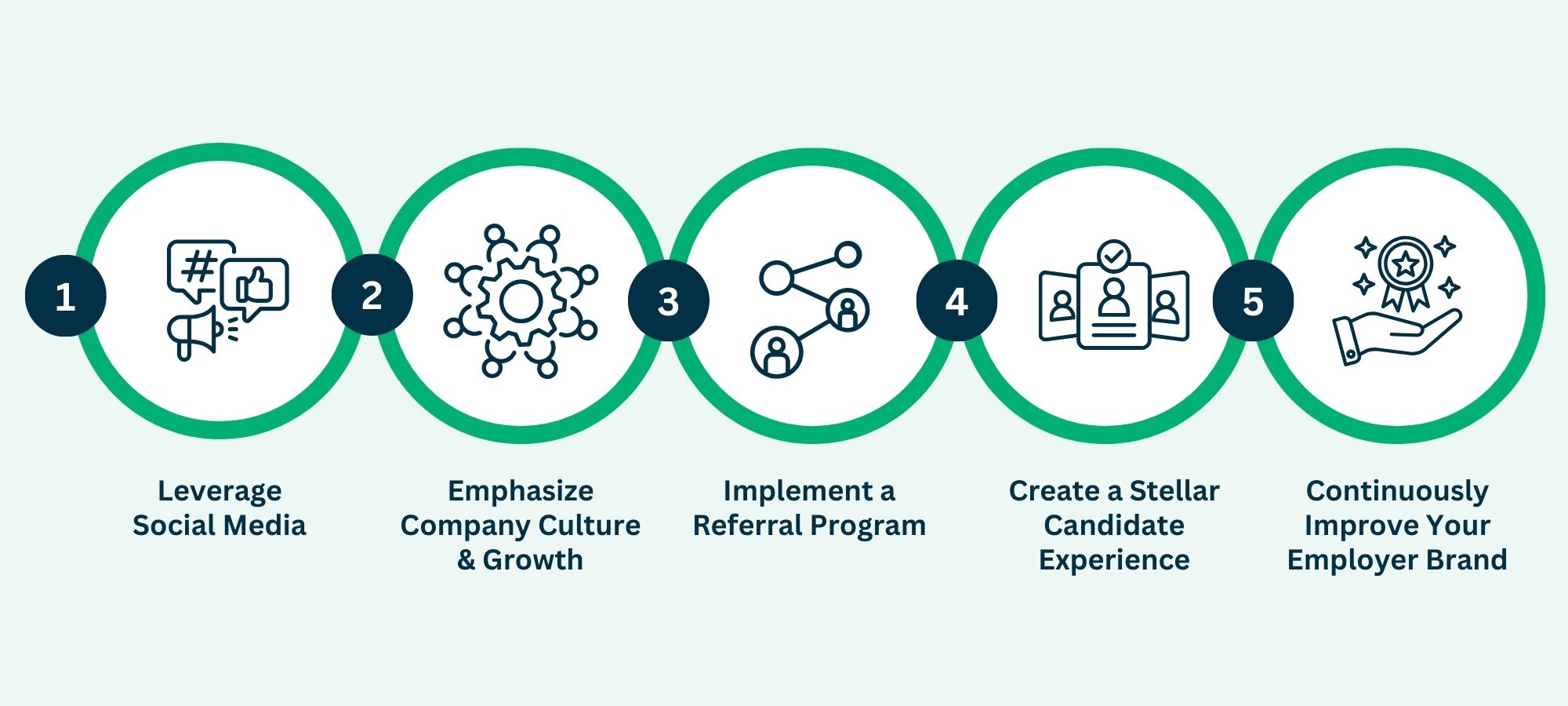Did you know that people who aren’t actually seeking new jobs get hired more often than those who are? It’s true: according to Glassdoor, 1 out of every 72 passive candidates is hired, compared to 1 hire out of every 152 active applicants.
Because they have already exhibited the skills and qualifications in their current roles, passive candidates can prove to be stronger and smarter hires.
The struggle, however, is finding the right ways to identify and engage with these working professionals.
This blog sheds some light on 5 sure-fire strategies for sourcing passive candidates:
- Leverage Social Media
- Emphasize Company Culture & Growth Potential
- Implement a Referral Program
- Continuously Improve Employer Brand
- Create a Stellar Candidate Experience

 Leverage Social Media
Leverage Social Media
Monitoring the social media channels of potential employers has become a new form of professional “window shopping.”
This means TA professionals can give prospective employees a curated insider’s view of what it’s like to work with your company. If the competition doesn’t pay much attention to their social presence, this strategy can definitely give you an edge.
When 84% of organizations report using social media to find candidates, you harm your ability to attract passive candidates by ignoring your company’s social media presence.
Adopting a cadence of frequent but not overwhelming posts offers context about workplace culture, informs followers of your vision, and confirms that your organization prioritizes keeping its community updated.
Sourcing #PassiveCandidates can be tricky, but with these 5 sure-fire strategies, you can engage and win over top talent: via @Visage_Jobs
Old School Trick: Call and Email
Email is still the best marketing channel for many B2B sales, so it also works well when you’re trying to connect with people who are already employed. You just need a few tweaks to update this method for today’s passive candidates.
Switch the order. Before, recruiters would call first, then follow up with an email. However, with passive candidates (or even active ones), this may seem a bit rude.
Instead, start with an email (grab info gleaned from social profiles to sound human) and then mention you’ll text them the details. Don’t text them the apply link.
Do the legwork. Why don’t we text the apply link? Well, it’s kind of lazy. For great, in-demand passive candidates, you need to stand out.
They’ve already been approached by time-wasting recruiters, but they’ll remember you as the hiring professional who doesn’t ask for a resume, an application, a pre-screen, a salary range, etc., and then decide they’re not a match.
Instead, confirm the information from their social media profiles and any resume you can access and give them the salary upfront.
Ramp expectations. What will they get from you if they give you 15 minutes of phone time? At the most, an incredible new career opportunity and a relationship within the company.
But at worst, you can help them update their resume or offer tips to polish their LinkedIn profile “for when they are ready to make a move.”
 Emphasize Company Culture & Growth Potential
Emphasize Company Culture & Growth Potential
Today’s job seekers have more power than ever due to the surplus of open positions and a shortage of talent. More selective candidates may seek specific employer benefits. Two significant draws for today’s talent include a healthy workplace culture and bountiful growth opportunities.
No one wants to work in a negative environment. Ensuring your workplace culture supports a strong work/life balance and prioritizes diversity and respect is critical if you hope to acquire top talent.
Like any other job-seekers, passive candidates crave professional development (PD) and growth. Before sourcing talent, check the strength of your professional development program. Creating paths for professional growth offers tremendous benefits to teams and companies alike.
The numbers don’t lie — professional development matters, especially if you want to attract and recruit passive talent. Employees who participate in professional development are:
- 15% more engaged
- 34% more likely to stay within their role
Old School Trick: Show Them THEIR Journey
Emphasize company growth to highlight your development program. Help candidates envision themselves as part of your company by describing some important projects they’ll work on. Include specifics, like the amazing people they’ll work with and how projects create endless opportunities to keep learning and grow their careers.
That level of promising detail is music to their ears, especially now, when a Leadership IQ study reveals only 35% of employees say they’re always learning something new at work.
Proven PD Strategies
While every company offers a different kind of professional development program, you can draw from some generally proven strategies in the list of sample statements below
1. Focus on coaching and feedback:
- We offer regular coaching and feedback sessions with managers to ensure each employee is growing and progressing in their career.
- Our biannual performance reviews incorporate feedback from colleagues, clients, and supervisors to help staff members maximize their potential.
- We track employee growth over time with our performance review system, which allows us to recognize their achievements and identify areas for improvement.
- Quarterly reviews and goal-setting sessions help to ensure our team members are on track to reach their highest potential.
- Engaging in monthly conversations with their employees allows our managers to get regular feedback on performance and areas for improvement.
2. Explore formal education or certifications:
- Our tuition reimbursement program offers employees opportunities to learn new skills and knowledge specific to current and future roles.
- All our employees can access educational resources like online courses and seminars so they can stay updated on industry trends and hone their professional skills.
- Our tuition reimbursement program encourages employees to pursue continuing education and gain new skills.
- We offer course reimbursement for further employee education and certifications in subjects relevant to their growth within the company.
3. Showcase professional development opportunities:
- Our professional development workshops equip employees with the necessary tools to grow and progress within the organization.
- We offer employees an extensive professional development program to help them build skills and gain experience in their chosen field.
- We also engage in various activities designed to foster collaboration between departments and teams, like hackathons, team-building events, and companywide socials.
4. Zero in on mentorship and collaboration:
- We offer mentoring opportunities with senior leadership to help employees develop their skills and advance their careers.
- Our robust mentorship program connects employees with experienced professionals and industry leaders who coach them along their career paths and help them meet their long-term goals.
- We provide quarterly career mapping sessions with managers to ensure our employees are on track for career advancement.
5. Show tangible ways the company offers career advancement:
- Employees have opportunities to accept additional responsibilities and lead projects that allow them to showcase their strengths and demonstrate leadership skills.
- Our internal job board allows team members to explore different company roles and bypass the external recruitment process.
- We create a consistent learning environment that provides all team members access to the latest developments in their field and offers constant management support to improve themselves professionally.
 Implement a Referral Program
Implement a Referral Program
Finding talent is tough. What’s worse is spending time and money to recruit a new hire, only for them to discover soon after that you’re not the right fit.
One way to avoid this is by relying on your current employees to help fill open positions.
A strong employee referral program can help you discover talent you’d never have found otherwise. And you can trust that the incoming referrals are quality candidates.
After all, your own employees know the culture and what it takes to succeed in these roles. They’re not likely to recommend someone who’s inexperienced or not up to the challenge.
As you build out your referral program, keep the following in mind:
- Make your employees feel appreciated for their referrals — everyone likes to be appreciated, and incoming referrals give you a reason to celebrate them. You don’t need much to show your team you’re thankful for help finding quality candidates.
- Keep the candidate and employee updated on the referral process — transparency in the hiring process is critical for a positive experience. Give your referring employee updates on the process, and keep your candidate in the loop, too!
- Be sure to reward engagement, not results — rewarding employees for referrals should occur immediately, even with small rewards. The best referral programs are built upon rewarding and encouraging referrals rather than rewarding successful hires. Frequent rewards and recognition go a long way to keep your team engaged in the process.
Old School: Referrals That Work
Using referrals to boost your hiring pool is nothing new. You don’t need the entire executive team’s buy-in to set up an official program, however. You never know who you need to know, so try out some old-fashioned, word-of mouth networking:
- Schedule a quick meet-and-greet with the engineering team at a local pub and ask them to bring a friend. Offer treats (candy bar, quality coffee, etc.) when folks come to your office to talk about referrals.
- Create excitement around new roles via the company intranet, employee communications, and in-office watering holes to draw attention to the roles you have the toughest time filling.
A referral fee is a small price to pay for employees who are more engaged, go through the process more quickly, and are proven to stay in their roles longer.
Try different strategies and approaches to encourage and reward referrals in your organization. There is no “one size fits all” approach; each organization is unique in its structure and operations.
Talk with your team to learn what they want from a referral program, and then work together to develop your strategy today.
Sourcing and recruiting passive candidates can help you fill positions quickly with quality hires. In today’s tight hiring market, passive candidates also significantly extend your network and talent pool. Finding and engaging passive candidates can be tricky, but you can secure high-quality talent and create a wider professional network with the right tools and strategies in place.
Reach out to us to see how Visage can help you connect with and secure passive candidates.
 Continuously Improve Employer Brand
Continuously Improve Employer Brand
With today’s tools and technologies, job seekers and passive candidates can research and read up on your company well before they ever engage with your job postings or hiring managers.
But, if you need more convincing, 75% of candidates are more likely to apply for a position with a company that actively manages its employer brand.
To establish a strong employer brand, your organization needs to look internally at your mission, values, and where priorities lie. This is the core of your business and should be communicated via external messaging and internal communications.
Answer questions like:
- What makes your organization different than your competitors?
- What makes you stronger?
- What do you do differently, and what makes it notable?
These questions can guide your employer branding strategy and give you insight into what exactly speaks to your target audience.
Tight talent market continues. It’s time to start building out a strategy for sourcing passive candidates: via @Visage_Jobs
Old School Trick: Employee-Generated Content!
One of the few good things to come out of the pandemic is the increased desire for imperfect content.
Invite employees to write blurbs on company values, make “A Day in the Life” video of their work, show off their favorite (silly) benefit of working there (free unlimited granola bars), or do a “10 Questions With”-type article, video, or podcast with various workers in the organization.
| Employee-Generated Content Ideas: |
|---|
| Ask employees to write a blog post about the company culture and how their job fits in with it. |
| Have employees record a video of their office space, discussing why they love working there and any unique features that make it special. |
| Ask employees to take pictures of themselves doing something fun or exciting related to the company, such as attending an event or using a new product/service. |
| Invite employees to create a podcast series discussing different topics related to the company, such as customer success stories, tips for success in the field, or interviews with key figures in the industry. |
| Encourage employees to write mini-profiles on various colleagues that highlight their talents and unique perspectives on the job. |
| Have current employees showcase any innovative technology they’re using within the organization and discuss how it has improved their workflows and productivity levels. |
| Ask employees to describe one accomplishment that they are most proud of achieving since joining the company, as well as how they leveraged their skillset to make it happen. |
| Request that workers submit short testimonials explaining why they chose this organization over others when seeking employment opportunities and what sets it apart from its competitors in terms of values and benefits offered by employers. |
| Create videos highlighting unique benefits like flexible work schedules, telecommuting opportunities, and interesting perks such as a monthly delivery of snacks or free gym memberships. |
| Feature photos of modern office spaces, including comfortable workspaces, recreational areas, and eye-catching artwork on the walls. |
| Record interviews with current employees discussing their favorite aspects of working with the organization, such as job satisfaction, growth opportunities, and professional development courses available to them. |
 Create a Stellar Candidate Experience
Create a Stellar Candidate Experience
Passive candidates need a good reason for leaving their current job. When your hiring process creates a poor candidate experience, it can dissuade someone from making the jump.
Whether active or passive, all candidates want to feel like they have a personalized experience and strong relationship with recruiters. The experience you provide should make candidates see the benefit of taking the leap and changing employers.
A robust, positive candidate experience can also help ease any tension or anxieties passive candidates may have about leaving their current job.
People who have a great candidate experience are more likely to share their experiences with others. Investing your time and efforts into constructing a strong, positive hiring experience can pay off exponentially in the long run.
Old School Trick: Audit Your Career Site Experience
Recruiters should audit their applicant experience to attract passive candidates because a positive experience can be one of the biggest persuasive factors to sway them from staying at their current job.
A good candidate experience shows passive candidates the potential benefits of switching to a new employer. It also builds trust between recruiters and candidates, which is essential for passive job seekers.
When recruiters invest time and effort in creating a great experience for applicants, they show passive candidates that they’re serious about offering a great job opportunity.
A great applicant experience can make potential passive candidates more comfortable about making the switch once they know they’ll be respected and treated well during the hiring process.
A strong candidate experience increases your likelihood of successfully hiring passive job seekers.
Questions for Auditing Your Site Experience
| Application Process | Are you clearly communicating the steps in the application process? |
| Do you have a system in place to track and follow up with candidates? | |
| Do you collect feedback from candidates at each stage of the process? | |
| Career Site | Is your career site mobile-friendly and easy to navigate? |
| Do you provide clear and concise job descriptions? | |
| Is there a way for candidates to easily apply for jobs on your site? | |
| Candidate Experience | Do you proactively reach out to candidates after they’ve applied? |
| Do you provide timely updates and feedback throughout the process? | |
| Do you make an effort to get to know each candidate on a personal level? |
Candidates should be able to find key information on job postings, benefits, and company culture quickly and easily.
Recruiters should consider adding online sections outlining the potential career growth opportunities and any unique benefits for passive candidates.
An organized, up-to-date career site will make it easier for passive candidates to evaluate whether or not making a change is in their best interest.

Director of Sourcing Operations at Visage, Evelyn has experience in agency, RPO, and in-house roles spanning 12 years in the recruitment industry. Evelyn has built and oversees a 4000-member global freelance sourcing community. Every Christmas in Ireland, she enjoys putting up her THREE Christmas trees.

